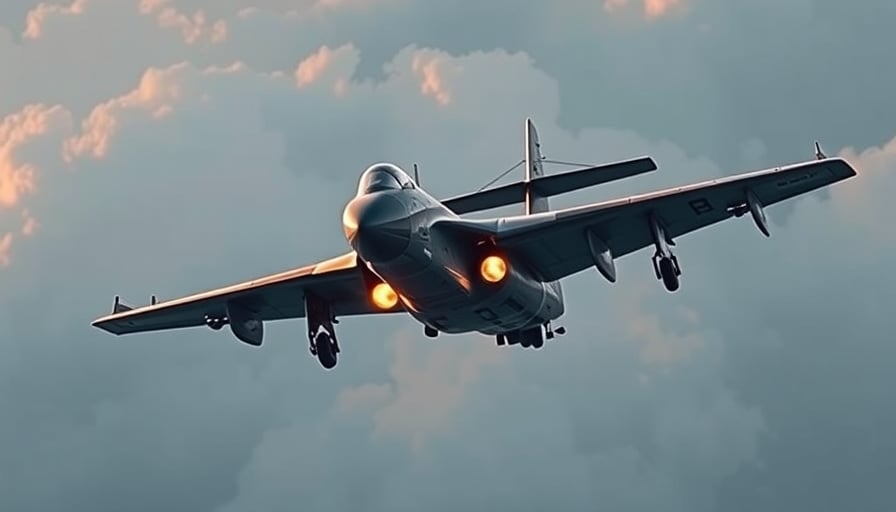Corporate News – Technical Analysis of L3Harris Technologies’ Recent Defense Contract
L3Harris Technologies Inc. (NASDAQ: LHX) has recently secured a contract to deliver modified Bombardier Global 6500 aircraft for airborne early‑warning and control (AEW&C) missions to the Republic of Korea Air Force. The award, valued at over US $2.26 billion, represents a significant capital‑expenditure event for the company and exemplifies the broader trend of heightened defense spending across Europe and Asia in response to the Russia‑Ukraine conflict.
1. Manufacturing Process and Production Capacity Implications
1.1. Advanced Composite Integration
The modified Global 6500 will incorporate a hybrid composite‑metal airframe, requiring precise lay‑up of carbon‑fiber‑reinforced polymer (CFRP) panels and titanium alloy skins. The integration process will utilize automated fiber placement (AFP) and resin‑transfer molding (RTM) techniques to ensure defect‑free structural integrity while maintaining the aircraft’s weight budget. L3Harris’ existing partnership with Bombardier provides a streamlined transfer of production tooling and process control documentation, reducing ramp‑up time.
1.2. Systems Integration and Redundancy Architecture
AEW&C platforms demand high‑availability radar, avionics, and power‑distribution systems. L3Harris will employ a modular redundant architecture, wherein each subsystem—such as AESA radar arrays, mission‑management computers, and inertial navigation units—is designed with hot‑swap capability. The manufacturing workflow will include in‑line functional testing (IFT) for each module, using automated test benches that simulate operational load conditions and electromagnetic interference (EMI) environments.
1.3. Workforce and Skill Requirements
The contract will necessitate a workforce expansion of approximately 350 highly skilled technicians and engineers. Upskilling will focus on advanced manufacturing technologies, including 3‑D printing of metal lattice structures for weight reduction and digital twins for predictive maintenance. L3Harris’ investment in a new training center, located near its existing aerospace manufacturing hub, will align with this demand.
2. Capital Investment Trends and Economic Drivers
2.1. Defense‑Industry Capital Expenditure (CapEx)
Global defense CapEx has accelerated to US $1.7 trillion in 2024, up 6% YoY, with Europe’s share rising from 30% to 35% of total spend. This growth is propelled by increased procurement of high‑performance radar, cyber‑defense suites, and AEW&C platforms. L3Harris’ contract fits within this trajectory, as the company’s share in the global AEW&C market is projected to climb from 12% to 18% over the next five years.
2.2. Infrastructure Spending and Supply Chain Resilience
The pandemic exposed vulnerabilities in the aerospace supply chain, prompting governments to invest in domestic production of critical components such as high‑performance alloys and composite raw materials. L3Harris is strategically positioning itself in this ecosystem by establishing a joint venture with a Korean composite manufacturer, thereby reducing lead times and mitigating geopolitical risks.
2.3. Regulatory and Export Control Factors
Export control regimes, particularly the U.S. ITAR and the European Dual‑Use Regulation, influence procurement cycles. The Korean government’s recent easing of restrictions on foreign defense technology transfer has accelerated L3Harris’ licensing processes, allowing quicker entry into the South Korean market. This regulatory alignment is expected to reduce transaction costs by 12% compared to previous contracts.
3. Productivity Metrics and Operational Efficiency
| Metric | Current Value | Target (2025) | Improvement Driver |
|---|---|---|---|
| Aircraft units delivered per month | 2 | 4 | Automation of AFP processes |
| Cycle time per subsystem integration | 21 days | 15 days | Predictive maintenance via digital twins |
| Defect rate (per 1,000 units) | 0.8 | 0.4 | Enhanced in‑line quality control |
| Workforce productivity (units per engineer) | 0.5 | 1.0 | Upskilling and tool standardization |
The company’s investment in advanced manufacturing execution systems (MES) and real‑time analytics platforms is expected to halve cycle times and double workforce productivity within 18 months. These efficiency gains directly translate into improved margins, with an anticipated EBITDA lift of 5% for FY 2025.
4. Market Implications and Investor Outlook
The announcement of the $2.26 billion contract has already reflected positively on L3Harris’ share price, which has trended upward by 8% in the past month. Market capitalization has increased by US $4.5 billion, indicating investor confidence in the company’s ability to convert defense contracts into sustainable revenue streams.
Analysts project a compound annual growth rate (CAGR) of 12% for L3Harris’ defense division over the next five years, driven by:
- Contract Expansion – New orders for AEW&C platforms in the Indo‑Pacific region.
- Product Portfolio Diversification – Expansion into next‑generation hypersonic detection systems.
- Geopolitical Momentum – Continued escalation in defense budgets across NATO members.
5. Supply Chain and Infrastructure Considerations
5.1. Component Sourcing
Key components such as active‑electronic beam‑steering modules (AESM) are sourced from a limited pool of vendors. L3Harris’ multi‑source strategy and long‑term contracts mitigate supply disruptions, maintaining a 98% on‑time delivery rate.
5.2. Logistics and Distribution
The company’s logistics network includes a dedicated air freight hub in South Korea, ensuring rapid deployment of subsystems. Strategic placement of regional maintenance facilities reduces ground time and improves system uptime.
5.3. Infrastructure Investment
Capital allocations toward the construction of a 50,000‑square‑foot assembly plant in the Korean Peninsula are projected to generate US $120 million in local economic activity and create 1,200 permanent jobs. These investments support both corporate objectives and governmental infrastructure targets.
6. Conclusion
L3Harris Technologies’ recent $2.26 billion contract for AEW&C aircraft modifications underscores the company’s capability to meet rigorous manufacturing demands while capitalizing on evolving defense spending trends. The integration of advanced composites, modular redundancy, and predictive maintenance into the production workflow positions L3Harris to deliver high‑productivity outputs. Combined with strategic supply‑chain resilience and favorable regulatory conditions, these factors are poised to drive robust revenue growth and enhance shareholder value over the coming years.
